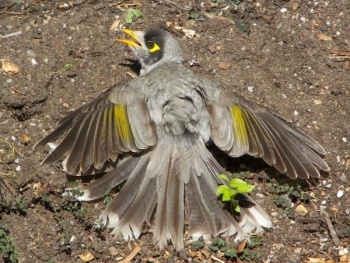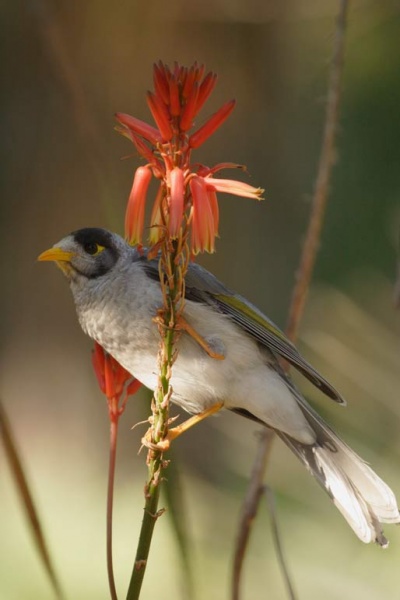- Manorina melanocephala
Identification

Photo © by David M Sargeant
Marcoola on the Sunshine Coast, Queensland, Australia, 28 December 2016
24–28 cm (9½-11 in)
- Adult has grey back, tail and breast
- White underparts
- White scalloping on the nape, hind-neck and breast
- Off-white forehad and lores
- Black band over the crown and cheeks
- Bright orange-yellow bill, legs and feet
- Distinctive patch of yellow skin behind the eye
- Prominent white tip to the tail
- Narrow olive-yellow wing panel
Sexes are similar. Juvenile is similar to the adult but with a softer plumage, brownish tinge to the black on its head and the grey on its back, and a duller, greyish-yellow skin patch behind the eye.
Similar Species
Yellow-throated Miner has a grey crown, white rump, and a line of bare yellow skin on the sides of the throat. The introduced Common Myna is is mostly dark brown and, although it has similar facial markings, it belongs to the starling family, while the miners are honeyeaters.
Distribution
Australia: found in New South Wales, Queensland, South Australia, Victoria, and Tasmania.
Taxonomy
Subspecies

Photo © by colonelboris
Royal Botanical Gardens, Sydney, New South Wales, Australia, 13 September 2009
This is a polytypic species. There are four subspecies.1
- M. m. titaniota: interior of southern Cape York Peninsula, northeastern Queensland
- Shorter tail, paler crown, larger yellow skin patch, and paler upper parts without the yellow-olive of the nominate subspecies.
- M. m. lepidota: Burdekin River (Queensland) to southwestern New South Wales, eastern Australia
- Smaller than the nominate race with a black crown, and darker more mottled upperparts.
- M. m. melanocephala: central New South Wales to southern Victoria and southeastern South Australia, southeastern Australia
- Heavier scalloping on hind-neck, smaller yellow skin patch and yellow-olive upperparts.
- M. m. leachi: eastern Tasmania
- Finer scalloping on the hind-neck than the nominate race, a more intense yellow tinge to the wing panels, and a slightly broader off-white tip to the tail
Habitat
Woodlands and open forests. They have also become well adapted to suburban situations and are commonly seen in parks and gardens.
Behaviour
Actions
These highly social birds are very aggressive and often drive away other species. Their hyper-aggressive colonial strategy has caused declines in a number of endangered or rare species.
Diet
Their main diet consists of invertebrates and nectar, with the addition of seeds and fruit. Occasionally they will also eat small reptiles and frogs.
Breeding
The female constructs the nest and incubates the eggs alone, but both sexes will care for and feed the young birds. Additional 'helpers' usually also feed the young. These helpers are almost always male birds.
Vocalisation
They have a noisy and complex repertoire including at least twelve different adult vocalizations, and a dawn song. Most calls are loud and penetrating consisting of harsh single notes.
Movements
Generally sedentary with limited dispersal to and from colonies. In some areas systematic culling has been used to remove them, but in most cases they recolonize.
References
- Clements, J. F., T. S. Schulenberg, M. J. Iliff, T. A. Fredericks, J. A. Gerbracht, D. Lepage, S. M. Billerman, B. L. Sullivan, and C. L. Wood. 2022. The eBird/Clements checklist of Birds of the World: v2022. Downloaded from https://www.birds.cornell.edu/clementschecklist/download/
- NSW.gov.aus
- Higgins, P., Christidis, L. & Ford, H. (2019). Noisy Miner (Manorina melanocephala). In: del Hoyo, J., Elliott, A., Sargatal, J., Christie, D.A. & de Juana, E. (eds.). Handbook of the Birds of the World Alive. Lynx Edicions, Barcelona. (retrieved from https://www.hbw.com/node/60318 on 17 December 2019).
- Vickers, J. A. T. (2017) Demographic shifts in Noisy Miner (Manorina melanocephala) populations following removal, BEnviSc Hons, School of Earth & Environmental Science, University of Wollongong. https://ro.uow.edu.au/thsci/145
Recommended Citation
- BirdForum Opus contributors. (2024) Noisy Miner. In: BirdForum, the forum for wild birds and birding. Retrieved 25 April 2024 from https://www.birdforum.net/opus/Noisy_Miner
External Links
GSearch checked for 2020 platform.1





